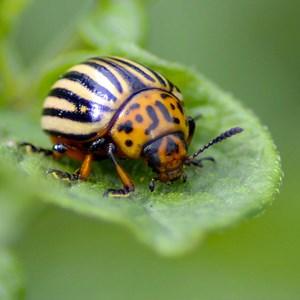Contact
niklas.bjorklund@slu.se, 018-672879, 070-5082879
johanna.boberg@slu.se, 018-671804

Larger projects that SLU Risk assessment of plant pests works with.
Quarantine pests are surveyed with the aim to aid early detection, to justify phytosanitary import requirements and/or to facilitate exports. Achieving the required degree of statistical confidence can be very challenging. Although the surveys are conducted regularly, the statistical confidence is generally calculated based only on data from the current year. However, the Finnish Food Authority has recently developed a web application that facilitates the use of data from several years of surveys. In a project funded by EFSA the web application was improved, e.g. by adding a GIS land cover data retriever. It will be used by partners from Estonia, Lithuania, Norway and Sweden to assess the statistical confidence gained in their previous multiannual surveys of the pine wood nematode (Bursaphelenchus xylophilus). The project was conducted between 2021 to 2023.
Project partners: Finland (Finnish Food Authority), Estonia (Estonian Agriculture and Food Board), Lithuania (The state plant service under the ministry of agriculture), Norway (Folkehelseinstituttet (VKM)).
In a recent study (Identification of new pest threats to Nordic coniferous forests)we identified several potential pests of Nordic coniferous forests associated with the trade of ornamental plants. In this project we will conduct PRAs for two of them, i.e. the white-marked tussock moth (Orgyia leucostigma) and the pine needle scale (Chionaspis pinifoliae). The PRAs will be done as a collaboration between the Nordic network for risk assessment of plant pests and the European and Mediterranean Plant Protection Organization (EPPO) according to their scheme for an Express Pest Risk Analysis. The PRAs can then be used to decide whether the assessed pests should be regulated as quarantine pests.
Project group: Mariela Marinova-Todorova, Juha Tuomola and Salla Hannunen from the Finnish Food Authority, Micael Wendell and Daniel Flø from VKM, Johanna Boberg and Niklas Björklund from SLU, and Camille Picard with colleagues at EPPO.
Publications:
The aim of the project was to assess the pest risks associated with trade of ornamental plants to the health of the Swedish, Norwegian and Finnish coniferous forests in present and future climates. A database of pests that could threaten major coniferous forestry species was prepared. The main pest species of importance and the commodities that can act as pathway of introduction were identified. The climate suitability for the pests was assessed, based on the current climate and based on the future warmer climate. The project focused on pests that potentially may fulfil the criteria to become regulated pests within the European Union according to the new EU regulation 2016/2031. The project was conducted in a collaboration between the risk assessment research unit at Finnish Food Safety Authority (Ruokavirasto), Norweigan Scientific Committee for Food and Environment (VKM) and the unit for risk assessment at Swedish University of Agricultural Sciences (SLU).
Project group: Mariela Marinova-Todorova (Evira), Juha Tuomola (Evira), Salla Hannunen (Evira), Micael Wendell (VKM), Daniel Flø (VKM), Johanna Boberg (SLU), Niklas Björklund (SLU).
Read the full study here: Marinova‐Todorova, M., Björklund, N., Boberg, J., Flø, D., Tuomola, J., Wendell, M., & Hannunen, S. (2020) Screening potential pests of Nordic coniferous forests associated with trade in ornamental plants. EPPO Bulletin 50 (2), 314-332 https://doi.org/10.1111/epp.12667
The overall aim of the project was to compile information to provide a knowledge base for the assessment of the economic consequences of new plant pests. Relevant information and data on the volumes of trade of plants and plant products that may provide pathways of introduction for invasive plant pests to Sweden and the economic value of plants at risk in Sweden was described. The project was conducted in collaboration with Greensway.
Läs rapporten Trade and production of plants and plant products in Sweden - A knowledge base for pest risk analysis
The aim of the project is to rank the regulated plant pests relevant for Sweden based on the risk they present. The model FinnPRIO developed by the Finnish Food Safety Authority (Ruokavirasto) will be applied also in Sweden. The assessments and risk ranking generated will provide support to the risk management of plant pests performed by Swedish Board of Agriculture.
The work to collect and synthesize the information necessary to rank all the relevant plant pests was performed as follows:
The aim of the proposed project is to gather and compile published data and information regarding the ecosystem services and biodiversity associated with the different tree species present in Sweden. The project is conducted in collaboration with Vítězslav Maňák.
niklas.bjorklund@slu.se, 018-672879, 070-5082879
johanna.boberg@slu.se, 018-671804